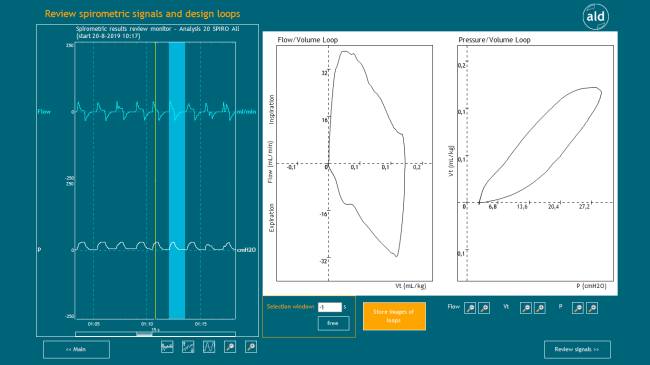Initialization of the SPIRO APP: Design Loops
Overview
Flow/Volume- and Pressure/Volume Loops can be designed for a previous spirometric FLOW/PRES analysisDetails
Spirometric results review monitorIn this viewer the flow and the inspiratory signal are previewed.
To scroll the signals in the reviewer, drag the scroll bar at the bottom to the left or right, or position the mouse on the yellow Center Cursor and drag it to the left or right.

Additionally the signals can be scaled and zoomed by clicking the respective buttons below this previewer (from left to right).
1. button: automatic zeroing of the offsets of all signals.
2. button: automatic adaption of all signal offsets (shifting up and down)
3. button: automatic scaling of all signals (adaptation of the shown signal ranges according to the value ranges of the signals) If a signal is indicated in the reviewer and it is not visible, this might be due to an inappropriate value range.
4. button: zoom out
5. button: zoom in
Flow/Volume Loop
This viewer shows flow volume loops.
The axis can be scaled by clicking the respective zoom out and zoom in buttons below the viewer
Pressure/Volume Loop
This viewer shows pressure volume loops.
The axis can be scaled by clicking the respective zoom out and zoom in buttons below the viewer
Store images of loops
This button stores the designed loops in a pdf file as Flow Vt loops and P Vt loops under the current analysis number.
Selection window
This input field allows to specify a fixed width of the window in s. The default value -1 shows a moving cursor. If the value is set to 0 no signal is selected and no cursor is shown.
Clicking the button free resets the selection window to the value -1.
<< Main
This button directs back to the initialization ("Initialization of the SPIRO APP").
Review signals >>
This button directs to the signal review ("Initialization of the SPIRO APP: Review spirometric signals of FLOW/PRES analysis").
